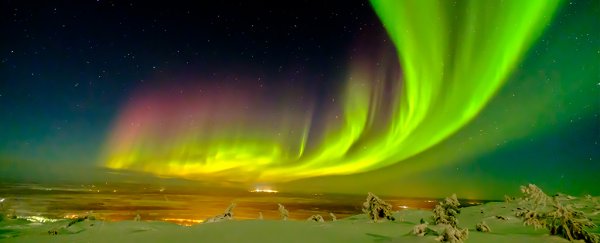Researchers have directly observed the scattering electrons behind the shifting patterns of light called pulsating auroras, confirming models of how charged solar winds interact with our planet's magnetic field.
With those same winds posing a threat to technology, it's comforting to know we've got a sound understanding of what's going on up there.
The international team of astronomers used the state-of-the-art Arase Geospace probe as part of the Exploration of energization and Radiation in Geospace (ERG) project to observe how high energy electrons behave high above the surface of our planet.
Dazzling curtains of light that shimmer over Earth's poles have captured our imagination since prehistoric times, and the fundamental processes behind the eerie glow of the aurora borealis and aurora australis – the northern and southern lights – are fairly well known.
Charged particles, spat out of the Sun by coronal mass ejections and other solar phenomena, wash over our planet in waves. As they hit Earth's magnetic field, most of the particles are deflected around the globe. Some are funnelled down towards the poles, where they smash into the gases making up our atmosphere and cause them to glow in sheets of dazzling greens, blues, and reds.
Those are typically called active auroras, and are often photographed to make up the gorgeous curtains we put onto calendars and desktop wallpapers.
But pulsating auroras are a little different.
Rather than shimmer as a curtain of light, they grow and fade over tens of seconds like slow lightning. They also tend to form higher up than their active cousins at the poles and closer to the equator, making them harder to study.
This kind of aurora is thought to be caused by sudden rearrangements in the magnetic field lines releasing their stored solar energy, sending showers of electrons crashing into the atmosphere in cycles of brightening called aurora substorms.
"They are characterised by auroral brightening from dusk to midnight, followed by violent motions of distinct auroral arcs that eventually break up, and emerge as diffuse, pulsating auroral patches at dawn," lead author Satoshi Kasahara from the University of Tokyo explains in their report.
Confirming specific changes in magnetic field are truly responsible for these waves of electrons isn't easy. For one thing, mapping the magnetic field lines with precision requires putting equipment into the right place at the right time in order to track charged particles trapped within them.
While the rearrangements of the magnetic field seem likely, there's still the question of whether there's enough electrons in these surges to account for the pulsating auroras.
This latest study has now put that question to rest.
The researchers directly observed the scattering of electrons produced by shifts in channelled currents of charged particles, or plasma, called chorus waves.
Electron bursts have been linked with chorus waves before, with previous research spotting electron showers that coincide with the 'whistling' tunes of these shifting plasma currents. But now they knew the resulting eruption of charged particles could do the trick.
"The precipitating electron flux was sufficiently intense to generate pulsating aurora," says Kasahara.
The clip below does a nice job of explaining the research using neat visuals. Complete with a wicked thumping dance beat.

The next step for the researchers is to use the ERG spacecraft to comprehensively analyse the nature of these electron bursts in conjunction with phenomena such as auroras.
These amazing light shows are spectacular to watch, but they also have a darker side.
Those light showers of particles can turn into storms under the right conditions. While they're harmless enough high overhead, a sufficiently powerful solar storm can cause charged particles to disrupt electronics in satellites and devices closer to the surface.
Just last year the largest flare to erupt from the Sun in over a decade temporarily knocked out high frequency radio and disrupted low-frequency navigation technology.
Getting a grip on what's between us and the Sun might help us plan better when even bigger storms strike.
This research was published in Nature.
